- Home
- Interesting Palm Facts
- Unique & Rare
Unique Palm Trees
Can These Exotics Work in Your Landscape?
Unique palm trees are a quirky part of palm tree biology.
You've probably heard there's around 2600+ different species of palm trees. We're here to show you some brand new (to palm biology!), very unique palms. Plus other unusual palm trees around the world.
Are you a tropical plant enthusiast, a curious gardener, or someone who loves nature’s weirdest wonders? You'll find this guide showcases palm trees like you've never seen before.
We'll explore the most unusual, rare, and visually stunning palms from around the world — including ones you can actually grow at home.
Come spot nine of the most unique palm trees. To discover why these species are in a tropical class of their own.
Let's get into it!
What Makes a Palm Tree Unique?
All palm trees are unique in the plant world.
Because though people call them "trees" they're not really that type of plant. Why?
Essentially because Palms Are Monocots:
- Their flowers have three parts - or multiples of three. For example, six, nine or twelve.
- Its first sprouting single leaf, after beginning germination, is called a cotyledon.
- Its Method For Getting Nutrients from the ground is totally different.
Not at all like the other plant forms, Which are the Dicots. Which is totally different.
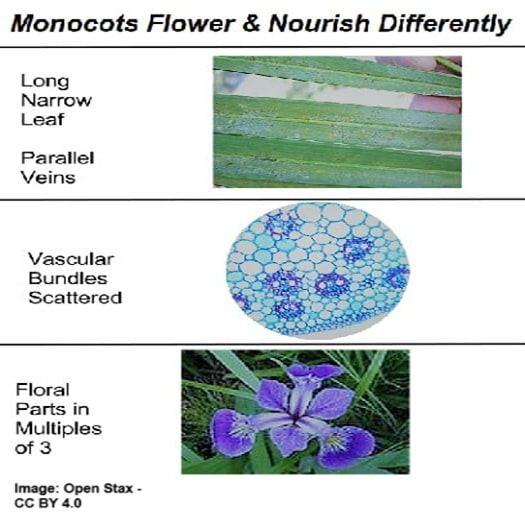
Palm Species Provide a Tale of Uniqueness
Not all palm trees fit the classic look of a tall trunk topped with flowing green fronds.
Since some palms have Interesting Facts About Them that are very unusual. They almost remind us something out of a fantasy film!
A palm is reckoned as “unique” when it has one or more of these traits:
- Uncommon appearance: Think striking colors, unusually tinted fronds, or bizarre shapes.
- Rare life cycles: Some palms bloom once in their lifetime — and then die.
- Exotic origins: Found in isolated islands or rare ecosystems like Madagascar or the Seychelles.
- Unusual functions: Palms have fascinating traditional medicinal uses, or are used in cultural rituals.
Unique palms appeal to those looking to create something truly unforgettable. Perhaps gardeners, collectors, or landscape designers. Who may think they're perfect for turning an ordinary garden or patio into an exotic escape.
We’ll now explore 12 of these unusual palm tree species — including where to find them.
Newly Discovered Palm Trees
Three of the Most Exciting
Most have been known for years and years. Yet out-of-this-world new species are still discovered on occasion.
Like when biologists, horticulturists and/or palm botanists go traipsing through tropical jungles doing field work. And suddenly they come upon something crazy-new in the palm world - that they'd never seen before. New species certainly cause jaw-dropping reactions!
Like the following palms:
- Which flowered backwards.
- Which were visible, yet unnoticed by palm experts. And have "invisible" palm parts.
- Which is a whole new Genera of palm species that is killed by used lots of energy.
Discovery in the Kabili-Sepilok Forest Reserve
In Malaysia, in 1964, W. Meijer was doing field work.
He saw a large grove of unusual palm trees in the Kabili-Sepilok Forest Reserve. He could tell they were in the Arenga Genus, because of their characteristics. But the details showed they weren't like anything known before.
So what exactly were these palms?
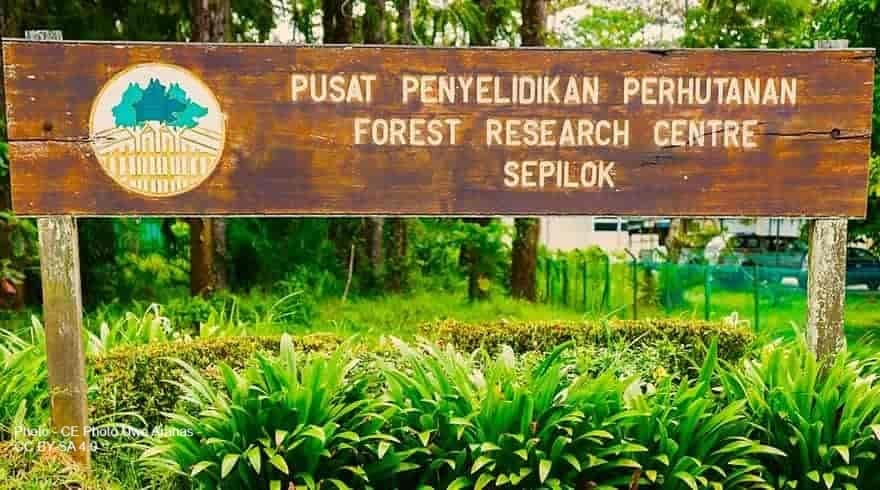 Fabulous place to do palm tree research!
Fabulous place to do palm tree research!Arengas normally begin flowering with inflorescences sprouting above the crown of fronds.
After that, inflorescences sprout further downward, year after year. This new palm discovery did just the opposite!
- The first flower stalk grows from the palm trunk base!
- And then with next flowering inflorescences begin rising upward.
They named this new palm discovery Arenga retroflorescens! Because the inflorescences grow out backwards! From lowest to higher, rather than higher to lower.
Unlike others in the Arenga genus.
Feeling overwhelmed by so many palm trees?
You're not alone. We Understand your headaches! At Mission: Palm Trees you'll find clear answers to questions & Step-By-Step Guidance, from real people. With solutions to help. No puzzling shoptalk. No tiring research. So it's easy & fun for you.
Palm Hiding in Plain Sight!
In the Steaming Rainforests of Western Borneo
Another was even more recently discovered by Royal Botanic Gardens (RBG) Kew researchers.
It happened in early 2023. The palm researchers initially were clued in by Malaysian biologist Paul Chai, who'd first seen it in the late 1990s. But never scientifically reported it. When KEW visited he mentioned it to them.
They had to go find it! And were surprised to see it was hiding in plain sight!
 Adult Pinanga subterranea won't show you its trunk!
Adult Pinanga subterranea won't show you its trunk!Growing throughout Lanjak Entimau Wildlife Sanctuary, on Borneo. They discovered 3 unusual things about it:
- The trunk grew fully underground (acaulescent). Which occurs in some Palm Tree Species.
- But unlike any other palm, its flowering inflorescence was also underground.
- Even when its infructescence produced fruit. Which is also underground!
- They named it Pinanga subterranea (for obvious reasons!).
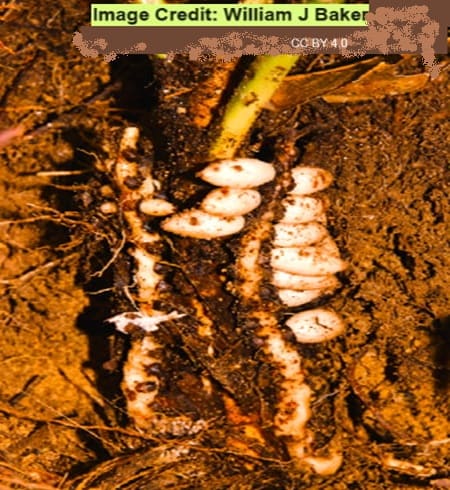 Exposing the newly sprouted Pinanga subterranea fruits growing adjacent to roots!
Exposing the newly sprouted Pinanga subterranea fruits growing adjacent to roots!Did you think, from what we found, that they were only recently discovered?
No exactly - not by locals! They've always dug up the fruit for a sweet snack.
In Borneo, depending on their own native language & location, it has these common names:
- Pinang Tanah
- Pinang Pipit
- Muring Pelandok
- Tudong Pelandok
The Bearded Pig also loves it, rooting out the fruit from underground. Then it spreads seeds around (from its natural rear outlet!).
Watch it in action...
Newest update
-
What Is Palm Wine? Definition, Origin, and Cultural Purpose Explained
We answer your question: what is palm wine? How it’s made, and why it’s treasured across Africa, Asia & South America. Learn its taste, and traditional uses.
Amazing New Palm Discovery in Madagascar
In the northwestern part of this Indian Ocean island, this captivating discovery was made in 2007.
Kew palm researcher, John Dransfield, was there. His student, Mijoro Rakotoarinivo, came along with him.
This discovery for the palm world began when a local cashew tree grower saw this palm while walking in the vicinity. He posted a photo on the Palm Talk Forum. To ask others what did they think this palm species was.
Dransfield noticed that post, and set out to figure it out. Planning his trip to Madagascar.
When he arrived and spotted it, he noticed it had some similarity to the Talipot Palm (Corypha umbraculifera). Which is also one of the unique palm trees in the world.
Here's the life of a Talipot Palm:
The Kew researching pair began obtaining samples of this newly found palm, for them. Their purpose was to perform DNA analysis.
When the results were ready, Dransfield realized it was an entirely new palm genus. They gave it the name Tahina. They determined it was a distant cousin to the genera Nannorrhops, Kerriodoxa & Chuniophoenix.
They named this species discovery Tahina spectabilis.
- Its huge trunk & height make it the tallest palm on the island of Madagascar.
- The splendid multibranched inflorescence grows upward from the crown.
- It produces small yellow flowers.
Its life-span is believed to be about 50 years. As that last year approaches the inflorescence produces tons of flowers. Which then become fruit when the flowers are fertilized.
That flowering/fruiting process depletes it so drastically that the palm dies a few months later!
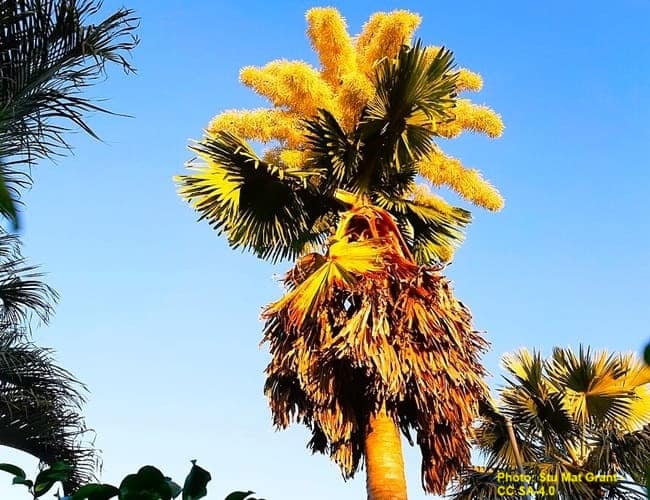
Tahina spectabilis is now listed as critically endangered.
It's protected in Madagascar. Preservation processes are underway by many organizations.
It has gotten these common names: Tahina Palm or Blessed Palm.
The Unique Double-Trunk Date Palm
Hyphaene thebaica is called African Doum Palm & Gingerbread palm.
An unusual palm species that naturally forms branches. Forming double (or even multiple) trunks. Making them a palm curiosity, because other palm trunks don't branch.
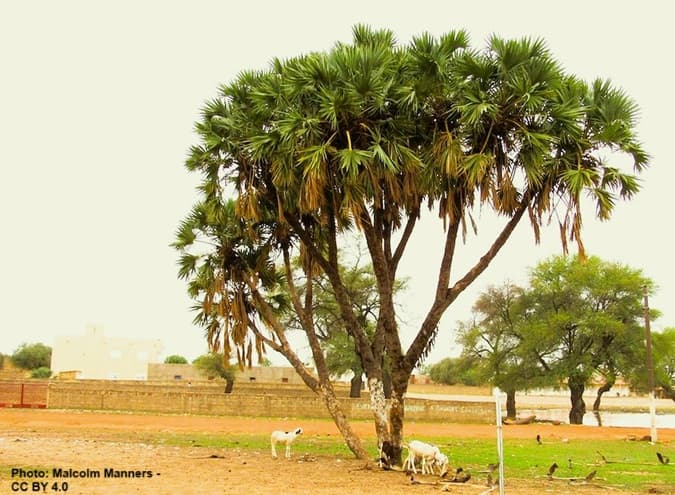 A cultivated Doum in eastern Senegal. As it's not native there.
A cultivated Doum in eastern Senegal. As it's not native there.Native to parts of arid Africa and the Middle East, it has a revered history as far back as 1800-B.C. The fruit has been found in Egyptian pharaoh tombs.
- The Doum dates taste like chewy gingerbread. Sometimes used to make juice or as historically concocted medicine.
- The fronds are fan-shaped and leathery, with thick spines along the petiole stem.
- This palm is dioecious — male and female flowers grow on separate plants.
The Black Trunk Palm
Kerriodoxa elegans is often called the Black Trunk Palm, White Elephant Palm or King Thai Palm.
A showstopper native to Thailand, botanical gardens were best. Now Growing in Modesto California, and places in Florida. As it's been getting more common in home landscaping.
Its deep-gray trunk stands out dramatically against its deep-green, huge, round fan leaves. Which look chalky white underneath. They're carried on black petioles, adding to the distinct contrast.
Because of its slow growth and unique appeal, it’s favored now by collectors and landscape designers alike. Not frost-tolerant, USDA zones 10–11 make for best success.
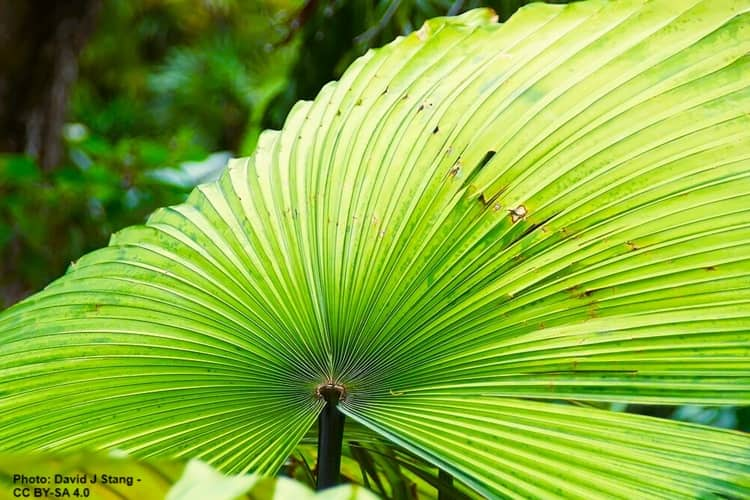 Note its thin black petiole on this palm stunner!
Note its thin black petiole on this palm stunner!From Vanuatu to Small Gardens
Licuala grandis is often referred to as the Ruffled Fan Palm.
With round, pleated, glossy green leaves notched around the edges. Each frond looks like a hand-held fan crafted from nature! Maxes out at 20ft/6m tall. So it's ideal for small spaces where alluring aesthetics matter.
It originated from Vanuatu, but also naturally grows in the Solomon Islands.
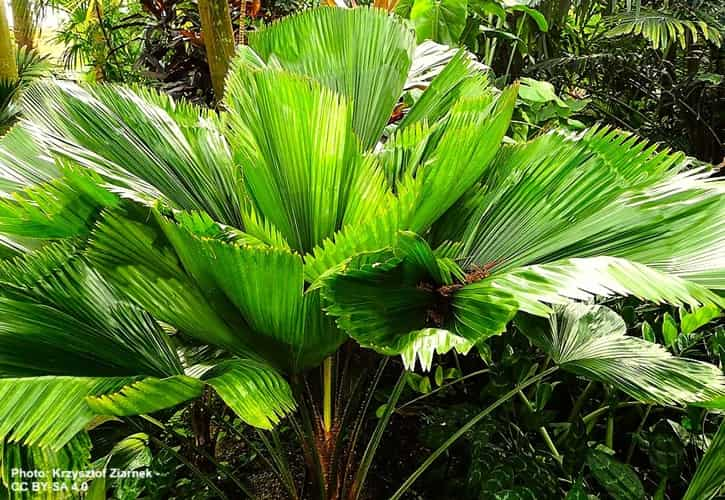 Landscape Tip: A wonderful centerpiece for Zen gardens, for an instant visual calm.
Landscape Tip: A wonderful centerpiece for Zen gardens, for an instant visual calm.Rare and Collectible Palms for Tropical Enthusiasts
For serious collectors and palm connoisseurs, there’s a world beyond common species.
These collectible palms are hard-to-find. But people seek them for the status, exclusivity, and visual drama.
Some of the most collectible palms include:
- Lodoicea maldivica (Coco de Mer) – Produces the world’s largest seed; extremely restricted in trade. See More About it Here>
- Coccothrinax crinita (Old Man Palm) – Covered in thick, fibrous “beard-like” hair.
- Chamaedorea metallica – Shimmering bluish metallic looking fronds leaves. Although not commonly used For Landscaping Plans, it can be purchased.
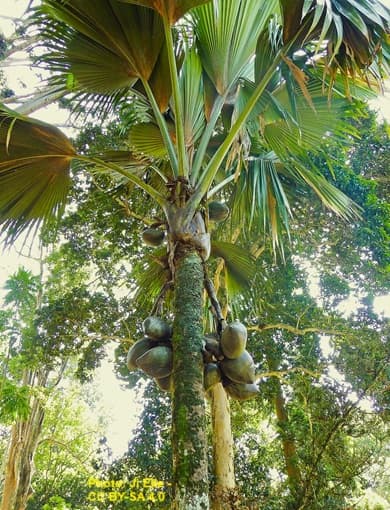 Coco de Mer
Coco de Mer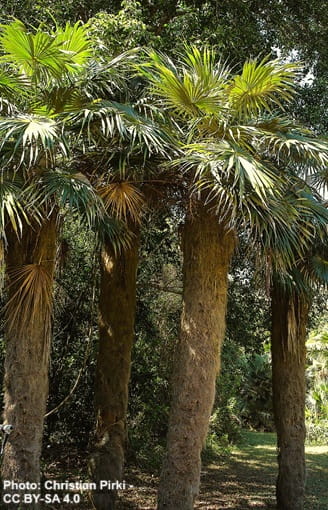 Old Man Palm
Old Man Palm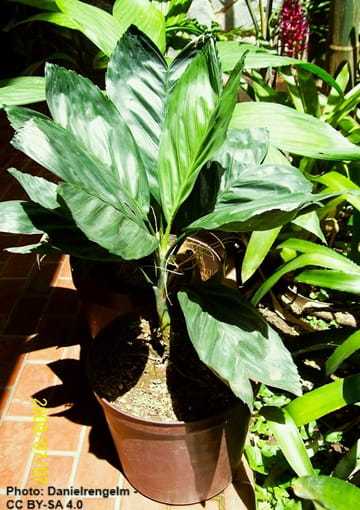 Metallica Palm
Metallica PalmRequirements to Purchase Unique Palm Trees
Unique, rare palms often require permits or specialist nurseries for acquiring.
Buying Tip: Only purchase rare palms from certified nurseries or botanical garden partners. Rarely found palms can be CITES-protected and/or illegal to access.
The term "CITES-protected," means it's listed under the Convention on International Trade in Endangered Species (CITES).
- A global agreement between 180+ countries to ensure trade in wild species doesn't threaten their survival.
- Some rare palm species (like Coco de Mer or Chrysalidocarpus decipiens) are so threatened in the wild, exporting or importing them requires permits, or is banned.
 The U.S. Mission organized a presentation to celebrate the 40th Anniversary of CITES.
The U.S. Mission organized a presentation to celebrate the 40th Anniversary of CITES.CITES Has Three Categories:
Appendix I: Most endangered — trade is generally prohibited.
Appendix II: Regulated trade - Somewhat endangered, conservation efforts in place.
Appendix III: Protected in at least one country. Trade allowed after proper documentation.
This matters to you if you plan to buy or import rare palms. Be sure:
- The seller has legal authority and documentation.
- The seller didn't obtain the palm through illegally wild-harvesting.
- The seller has shown you how to access the needed import/export permits for ownership.
Violating CITES regulations can lead to palm confiscation, fines, or legal action. Not realizing it was illegal is not tolerated as an excuse.
Takeaways for unique palm trees
Choose the right unique Palm Tree for your space!
That involves the desire to have a rare beauty, with conversation-starting features. But if you want to have collectible palms like those rare and recently discovered species, it's important to go about it the proper way.
Plus be sure to match your choice with your local growing conditions, while checking for any restrictions on rare species.
A unique palm tree may be the standout statement you're looking for, but would it be a wise purchase?





